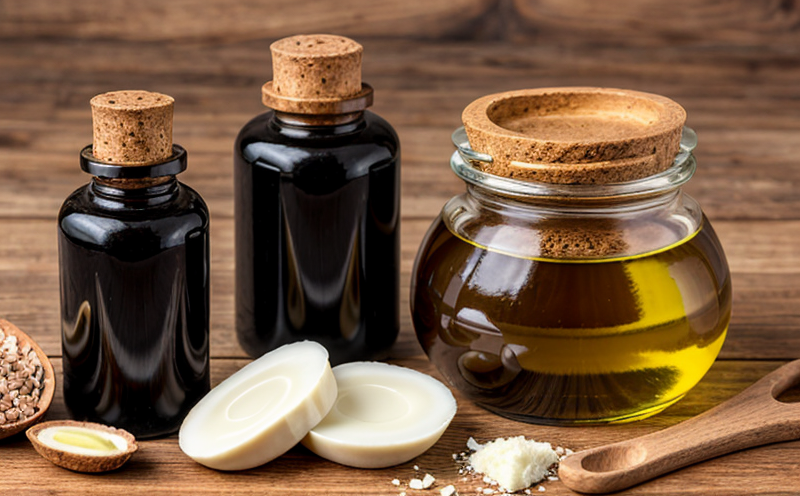EN 14538 Trace Metals Detection in Edible Oils
The European Standard EN 14538 specifies the procedure for determining trace amounts of metals, including iron (Fe), copper (Cu), lead (Pb), and cadmium (Cd) in edible oils. This testing is crucial for ensuring the safety and quality of food products that consumers trust every day.
Trace metal contamination can have serious health implications if not properly managed. For instance, high levels of lead or cadmium can cause neurological disorders and other adverse effects on human health. By adhering to EN 14538, laboratories provide accurate data that informs regulatory compliance and helps protect public health.
The methodology outlined in this standard ensures reliable results through precise sample preparation and state-of-the-art analytical techniques. Sample preparation involves thorough extraction of metals from the edible oil matrix using appropriate solvents followed by dilution to ensure accuracy within the detection limits specified in EN 14538.
Once prepared, samples are analyzed via atomic absorption spectrometry (AAS) or inductively coupled plasma optical emission spectrometry (ICPOES). These methods provide high sensitivity and selectivity necessary for detecting trace metal concentrations at parts per billion levels. The results obtained must meet the strict tolerances set forth by EN 14538.
Our laboratory utilizes advanced instrumentation such as PerkinElmer AAnalyst software for data analysis and reporting purposes. This ensures consistent, repeatable measurements that comply with international standards including ISO/IEC 17025:2017.
The scope of EN 14538 covers various types of edible oils such as olive oil, sunflower oil, soybean oil, corn oil, and others commonly used in food production. Compliance testing is particularly important for imported goods where local regulations may differ from those applied during manufacturing processes abroad.
Testing trace metals in edible oils helps prevent potential contamination issues that could arise due to poor hygiene practices or accidental adulteration with hazardous substances. It also supports ongoing quality control efforts aimed at maintaining consistent product quality across batches and suppliers.
In summary, EN 14538 plays a vital role in safeguarding consumer health by ensuring the absence of harmful trace metals in edible oils. Adherence to this standard demonstrates a commitment to safety and excellence within the food industry.
Scope and Methodology
The scope of EN 14538 encompasses the determination of trace metal elements present at very low concentrations in edible oils. It applies to all types of vegetable, animal fat, or mixed fats derived from such sources intended for human consumption.
- Iron (Fe)
- Copper (Cu)
- Potassium (K)
- Sodium (Na)
- Boron (B)
The standard specifies the sampling procedure, sample preparation methods, and analytical techniques required to achieve accurate results. Sampling should be representative of the entire batch being tested to ensure that the test reflects true metal content.
Sample preparation typically involves dissolving the solid matrix in a suitable solvent followed by filtering and dilution if needed. The choice of solvent depends on the type of oil and desired analytes but must not interfere with the subsequent analysis.
Analytical techniques used include atomic absorption spectrometry (AAS) and inductively coupled plasma optical emission spectrometry (ICPOES). Both methods offer high sensitivity and selectivity suitable for detecting trace metal concentrations down to parts per billion levels. AAS measures light absorbed by free atoms while ICPOES detects characteristic emissions from excited ions.
Data processing involves calibration curves prepared using certified reference materials (CRMs) against which unknown samples are compared. Reporting follows strict guidelines provided in EN 14538 ensuring that all results are presented clearly and accurately alongside any necessary comments or explanations regarding potential deviations from expected values.
Eurolab Advantages
At Eurolab, our expertise in food & feed testing sets us apart as the premier choice for EN 14538 compliance services. With years of experience and state-of-the-art facilities, we offer unparalleled accuracy, reliability, and speed when it comes to detecting trace metals in edible oils.
Our highly trained technicians employ cutting-edge instrumentation and follow rigorous quality assurance protocols to ensure every result is precise and trustworthy. Whether you need routine testing or one-off assessments, Eurolab delivers consistent performance that meets even the most stringent requirements.
We pride ourselves on providing comprehensive support throughout your project lifecycle from initial consultation through final report delivery. Our dedicated team works closely with clients to understand their specific needs ensuring tailored solutions are implemented effectively.
Choosing Eurolab means peace of mind knowing you're working with an ISO/IEC 17025:2017 accredited laboratory committed to excellence in food safety and quality assurance.
Use Cases and Application Examples
Detecting trace levels of iron (Fe) which could indicate contamination from rust or other metal parts during processing.
Identifying copper (Cu) as a marker for potential brass alloy contamination in processed foods containing edible oils.
In addition to these specific applications, EN 14538 plays an integral role in ensuring the overall quality and safety of food products. It supports regulatory compliance initiatives aimed at protecting consumers from harmful substances while fostering confidence among stakeholders involved in food supply chains.
Our comprehensive approach ensures that all aspects of trace metal detection are covered effectively allowing businesses to make informed decisions based on accurate data provided by Eurolab's EN 14538 services.





